Microstructure and Mechanical Property Evolution during Annealing of a Cold-Rolled Metastable Powder Metallurgy High Entropy Alloy
Abstract
:1. Introduction
2. Materials and Methods
3. Results
3.1. Microstructures
3.2. Mechanical Properties
4. Discussion
5. Conclusions
- (1)
- The powder metallurgy extruded CoCrFeNiMo0.2 HEA has a single FCC structure. After cold-rolling and heat-treatment, a (Cr, Mo)-rich σ with TCP structure can precipitate in the HEA.
- (2)
- CoCrFeNiMo0.2 HEA annealed at 800 °C for 12 h achieved the best overall mechanical property of 1.2 GPa tensile strength and 31% fracture strain, which can be expected to be a good candidate of high-strength and high-tenacity structural materials.
- (3)
- The excellent mechanical properties may be attributed to precipitation strengthening and fine grain strengthening. The present process could be considered as a promising means of fabricating high performance HEAs.
Author Contributions
Funding
Conflicts of Interest
References
- Huang, P.K.; Yeh, J.W.; Shun, T.T.; Chen, S.K. Multi-Principal-Element Alloys with Improved Oxidation and Wear Resistance for Thermal Spray Coating. Adv. Eng. Mater. 2004, 6, 74–78. [Google Scholar] [CrossRef]
- Yeh, J.W.; Chen, S.K.; Lin, S.J.; Gan, J.Y.; Chin, T.S.; Shun, T.T.; Tsau, C.H.; Chang, S.Y. Nanostructured high-entropy alloys with multiple principal elements: novel alloy design concepts and outcomes. Adv. Eng. Mater. 2004, 6, 299–303. [Google Scholar] [CrossRef]
- Otto, F.; Dlouhý, A.; Somsen, C.; Bei, H.; Eggeler, G.; George, E.P. The influences of temperature and microstructure on the tensile properties of a CoCrFeMnNi high-entropy alloy. Acta Mater. 2013, 61, 5743–5755. [Google Scholar] [CrossRef] [Green Version]
- Gludovatz, B.; Hohenwarter, A.; Catoor, D.; Chang, E.H.; George, E.P.; Ritchie, R.O. A fracture-resistant high-entropy alloy for cryogenic applications. Science 2014, 345, 1153. [Google Scholar] [CrossRef]
- Youssef, K.M.; Zaddach, A.J.; Niu, C.; Irving, D.L.; Koch, C.C. A Novel Low-Density, High-Hardness, High-entropy Alloy with Close-packed Single-phase Nanocrystalline Structures. Mater. Res. Lett. 2015, 3, 95–99. [Google Scholar] [CrossRef]
- Wu, Q.; Wang, Z.; Zheng, T.; Chen, D.; Yang, Z.; Li, J.; Kai, J.; Wang, J. A casting eutectic high entropy alloy with superior strength-ductility combination. Mater. Lett. 2019, 253, 268–271. [Google Scholar] [CrossRef]
- Yu, Y.; He, F.; Qiao, Z.; Wang, Z.; Liu, W.; Yang, J. Effects of temperature and microstructure on the triblogical properties of CoCrFeNiNbx eutectic high entropy alloys. J. Alloys Compd. 2019, 775, 1376–1385. [Google Scholar] [CrossRef]
- He, J.Y.; Liu, W.H.; Wang, H.; Wu, Y.; Liu, X.J.; Nieh, T.G.; Lu, Z.P. Effects of Al addition on structural evolution and tensile properties of the FeCoNiCrMn high-entropy alloy system. Acta Mater. 2014, 62, 105–113. [Google Scholar] [CrossRef]
- Zhang, Y.; Zuo, T.T.; Tang, Z.; Gao, M.C.; Dahmen, K.A.; Liaw, P.K.; Lu, Z.P. Microstructures and properties of high-entropy alloys. Prog. Mater. Sci. 2014, 61, 1–93. [Google Scholar] [CrossRef]
- Zou, Y.; Ma, H.; Spolenak, R. Ultrastrong ductile and stable high-entropy alloys at small scales. Nat. Commun. 2015, 6, 7748. [Google Scholar] [CrossRef] [Green Version]
- Senkov, O.N.; Senkova, S.V.; Woodward, C. Effect of aluminum on the microstructure and properties of two refractory high-entropy alloys. Acta Mater. 2014, 68, 214–228. [Google Scholar] [CrossRef]
- Senkov, O.N.; Scott, J.M.; Senkova, S.V.; Miracle, D.B.; Woodward, C.F. Microstructure and room temperature properties of a high-entropy TaNbHfZrTi alloy. J. Alloys Compd. 2011, 509, 6043–6048. [Google Scholar] [CrossRef]
- Takeuchi, A.; Amiya, K.; Wada, T.; Yubuta, K.; Wei, Z. High-entropy alloys with a hexagonal close-packed structure designed by equi-atomic alloy strategy and binary phase diagrams. JOM 2014, 66, 1984–1992. [Google Scholar] [CrossRef]
- Jiang, S.; Wang, H.; Wu, Y.; Liu, X.; Chen, H.; Yao, M.; Gault, B.; Ponge, D.; Raabe, D.; Hirata, A.; et al. Ultrastrong steel via minimal lattice misfit and high-density nanoprecipitation. Nature 2017, 544, 460. [Google Scholar] [CrossRef] [PubMed]
- Sun, Z.; Liebscher, C.H.; Huang, S.; Teng, Z.; Song, G.; Wang, G.; Asta, M.; Rawlings, M.; Fine, M.E.; Liaw, P.K. New design aspects of creep-resistant NiAl-strengthened ferritic alloys. Scr. Mater. 2013, 68, 384–388. [Google Scholar] [CrossRef]
- Teng, Z.K.; Ghosh, G.; Miller, M.K.; Huang, S.; Clausen, B.; Brown, D.W.; Liaw, P.K. Neutron-diffraction study and modeling of the lattice parameters of a NiAl-precipitate-strengthened Fe-based alloy. Acta Mater. 2012, 60, 5362–5369. [Google Scholar] [CrossRef]
- Kim, S.-H.; Kim, H.; Kim, N.J. Brittle intermetallic compound makes ultrastrong low-density steel with large ductility. Nature 2015, 518, 77. [Google Scholar] [CrossRef] [PubMed]
- Pickering, E.J.; Munoz-Moreno, R.; Stone, H.J.; Jones, N.G. Precipitation in the equiatomic high-entropy alloy CrMnFeCoNi. Scr. Mater. 2016, 113, 106–109. [Google Scholar] [CrossRef]
- He, F.; Wang, Z.; Niu, S.; Wu, Q.; Li, J.; Wang, J.; Liu, C.T.; Dang, Y. Strengthening the CoCrFeNiNb0.25 high entropy alloy by FCC precipitate. J. Alloys Compd. 2016, 667, 53–57. [Google Scholar] [CrossRef]
- He, J.Y.; Wang, H.; Huang, H.L.; Xu, X.D.; Chen, M.W.; Wu, Y.; Liu, X.J.; Nieh, T.G.; An, K.; Lu, Z.P. A precipitation-hardened high-entropy alloy with outstanding tensile properties. Acta Mater. 2016, 102, 187–196. [Google Scholar] [CrossRef] [Green Version]
- Liu, W.H.; Lu, Z.P.; He, J.Y.; Luan, J.H.; Wang, Z.J.; Liu, B.; Liu, Y.; Chen, M.W.; Liu, C.T. Ductile CoCrFeNiMox high entropy alloys strengthened by hard intermetallic phases. Acta Mater. 2016, 116, 332–342. [Google Scholar] [CrossRef]
- Li, Z.; Pradeep, K.G.; Deng, Y.; Raabe, D.; Tasan, C.C. Metastable high-entropy dual-phase alloys overcome the strength–ductility trade-off. Nature 2016, 534, 227. [Google Scholar] [CrossRef] [PubMed]
- Liu, P.P.; Zhao, M.Z.; Zhu, Y.M.; Bai, J.W.; Wan, F.R.; Zhan, Q. Effects of carbide precipitate on the mechanical properties and irradiation behavior of the low activation martensitic steel. J. Alloys Compd. 2013, 579, 599–605. [Google Scholar] [CrossRef]
- Otto, F.; Yang, Y.; Bei, H.; George, E.P. Relative effects of enthalpy and entropy on the phase stability of equiatomic high-entropy alloys. Acta Mater. 2013, 61, 2628–2638. [Google Scholar] [CrossRef] [Green Version]
- Rehman, H.u.; Durst, K.; Neumeier, S.; Parsa, A.B.; Kostka, A.; Eggeler, G.; Göken, M. Nanoindentation studies of the mechanical properties of the μ phase in a creep deformed Re containing nickel-based superalloy. Mater. Sci. Eng. A 2015, 634, 202–208. [Google Scholar] [CrossRef]
- Rae, C.M.F.; Reed, R.C. The precipitation of topologically close-packed phases in rhenium-containing superalloys. Acta Mater. 2001, 49, 4113–4125. [Google Scholar] [CrossRef]
- Yang, Q.; Tang, Y.; Wen, Y.; Zhang, Q.; Deng, D.; Nai, X. Microstructures and properties of CoCrCuFeNiMox high-entropy alloys fabricated by mechanical alloying and spark plasma sintering. Powder Metall. 2018, 61, 115–122. [Google Scholar] [CrossRef]
- Juan, C.-C.; Tseng, K.-K.; Hsu, W.-L.; Tsai, M.-H.; Tsai, C.-W.; Lin, C.-M.; Chen, S.-K.; Lin, S.-J.; Yeh, J.-W. Solution strengthening of ductile refractory HfMoxNbTaTiZr high-entropy alloys. Mater. Lett. 2016, 175, 284–287. [Google Scholar] [CrossRef]
- Shun, T.-T.; Hung, C.-H.; Lee, C.-F. Formation of ordered/disordered nanoparticles in FCC high entropy alloys. J. Alloys Compd. 2010, 493, 105–109. [Google Scholar] [CrossRef]
- Shun, T.-T.; Chang, L.-Y.; Shiu, M.-H. Microstructure and mechanical properties of multiprincipal component CoCrFeNiMox alloys. Mater. Charact. 2012, 70, 63–67. [Google Scholar] [CrossRef]
- Shun, T.-T.; Chang, L.-Y.; Shiu, M.-H. Age-hardening of the CoCrFeNiMo0.85 high-entropy alloy. Mater. Charact. 2013, 81, 92–96. [Google Scholar] [CrossRef]
- Csaki, I.; Karlsdottir, S.N.; Serghiuta, S.; Popescu, G.; Buzatu, M.; Geambazu, L.E.; Manea, C.A. CoCrFeNiMo high entropy alloy produced by solid state processing. Key Eng. Mater. 2017, 750, 15–19. [Google Scholar] [CrossRef]
- Wu, W.; Guo, L.; Liu, B.; Ni, S.; Liu, Y.; Song, M. Effects of torsional deformation on the microstructures and mechanical properties of a CoCrFeNiMo0.15 high-entropy alloy. Philos. Mag. 2017, 97, 3229–3245. [Google Scholar] [CrossRef]
- Bae, J.W.; Park, J.M.; Moon, J.; Choi, W.M.; Lee, B.-J.; Kim, H.S. Effect of μ-precipitates on the microstructure and mechanical properties of non-equiatomic CoCrFeNiMo medium-entropy alloys. J. Alloys Compd. 2019, 781, 75–83. [Google Scholar] [CrossRef]
- Wu, Q.; Wang, Z.; He, F.; Li, J.; Wang, J. Revealing the Selection of σ and μ Phases in CoCrFeNiMox High Entropy Alloys by CALPHAD. J. Phase Equilib. Diff. 2018, 39, 446–453. [Google Scholar] [CrossRef]
- Cai, B.; Liu, B.; Kabra, S.; Wang, Y.; Yan, K.; Lee, P.D.; Liu, Y. Deformation mechanisms of Mo alloyed FeCoCrNi high entropy alloy: In situ neutron diffraction. Acta Mater. 2017, 127, 471–480. [Google Scholar] [CrossRef] [Green Version]
- Yasuda, H.Y.; Miyamoto, H.; Cho, K.; Nagase, T. Formation of ultrafine-grained microstructure in Al0.3 CoCrFeNi high entropy alloys with grain boundary precipitates. Mater. Lett. 2017, 199, 120–123. [Google Scholar] [CrossRef]
- Stepanov, N.D.; Shaysultanov, D.G.; Chernichenko, R.S.; Ikornikov, D.M.; Sanin, V.N.; Zherebtsov, S.V. Mechanical properties of a new high entropy alloy with a duplex ultra-fine grained structure. Mater. Sci. Eng. A 2018, 728, 54–62. [Google Scholar] [CrossRef]
- Klimova, M.V.; Shaysultanov, D.G.; Zherebtsov, S.V.; Stepanov, N.D. Effect of second phase particles on mechanical properties and grain growth in a CoCrFeMnNi high entropy alloy. Mater. Sci. Eng. A 2019, 748, 228–235. [Google Scholar] [CrossRef]
- Liu, B.; Wang, J.; Liu, Y.; Fang, Q.; Wu, Y.; Chen, S.; Liu, C.T. Microstructure and mechanical properties of equimolar FeCoCrNi high entropy alloy prepared via powder extrusion. Intermetallics 2016, 75, 25–30. [Google Scholar] [CrossRef]
- Liu, B.; Xu, L.; Liu, Y.; Wang, J.; Wang, J.; Fang, Q. Effect of cold working and annealing on microstructure and properties of powder metallurgy high entropy alloy. Sci. China Technol. Sci. 2018, 61, 197–203. [Google Scholar] [CrossRef]
- Ghosh, P.; Ray, R.K.; Bhattacharya, B.; Bhargava, S. Precipitation and texture formation in two cold rolled and batch annealed interstitial-free high strength steels. Scripta Mater. 2006, 55, 271–274. [Google Scholar] [CrossRef]
- Heo, N.J.; Nagasaka, T.; Muroga, T. Recrystallization and precipitation behavior of low-activation V–Cr–Ti alloys after cold rolling. J. Nucl. Mater. 2004, 325, 53–60. [Google Scholar] [CrossRef]
- Hou, J.; Zhang, M.; Ma, S.; Liaw, P.K.; Zhang, Y.; Qiao, J. Strengthening in Al0.25CoCrFeNi high-entropy alloys by cold rolling. Mater. Sci. Eng. A 2017, 707, 593–601. [Google Scholar] [CrossRef]
- Hou, J.; Shi, X.; Qiao, J.; Zhang, Y.; Liaw, P.K.; Wu, Y. Ultrafine-grained dual phase Al0.45CoCrFeNi high-entropy alloys. Mater. Des. 2019, 180, 107910. [Google Scholar] [CrossRef]
- Mei, Y.; Liu, Y.; Liu, C.; Li, C.; Yu, L.; Guo, Q.; Li, H. Effects of cold rolling on the precipitation kinetics and the morphology evolution of intermediate phases in Inconel 718 alloy. J. Alloys Compd. 2015, 649, 949–960. [Google Scholar] [CrossRef]
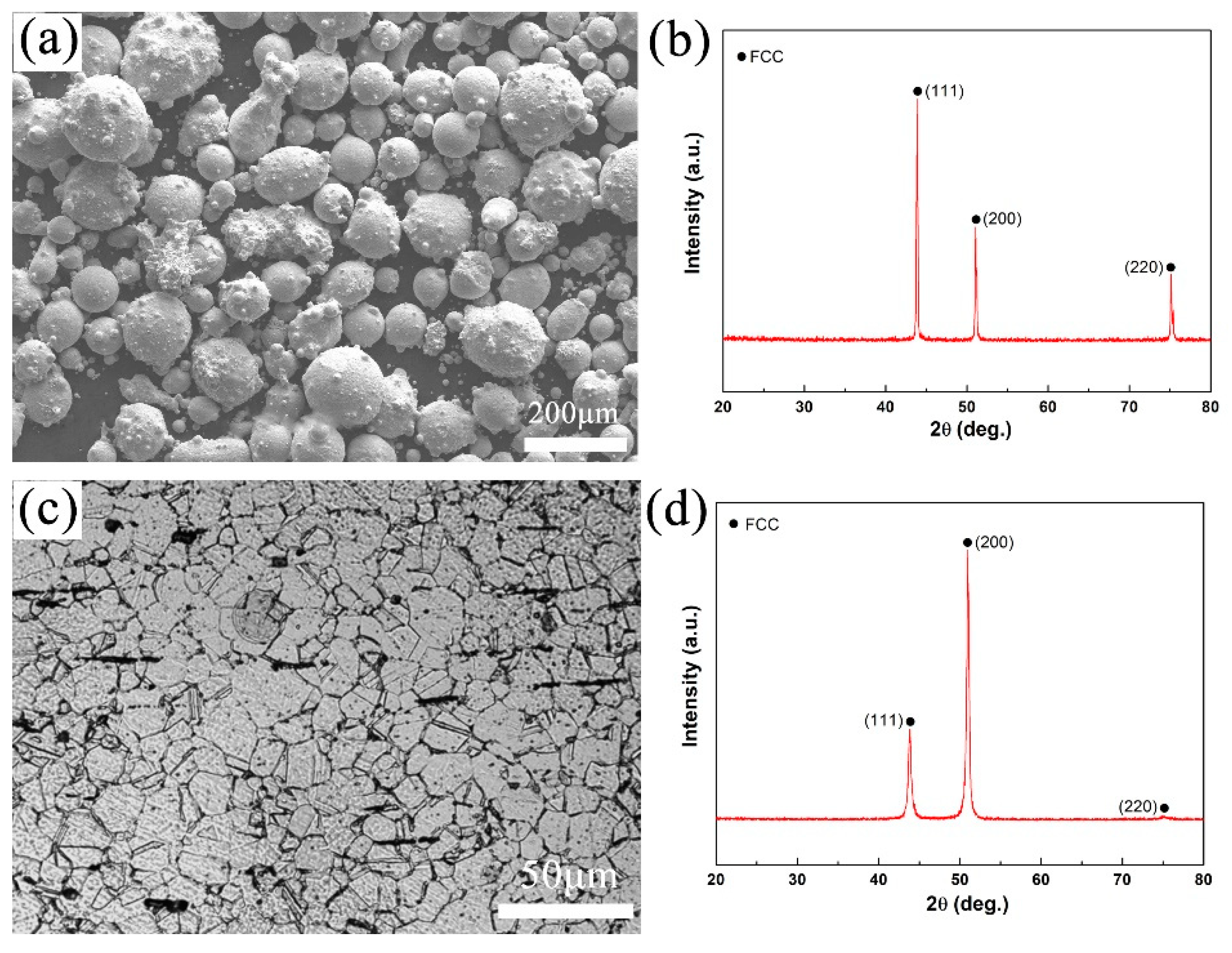



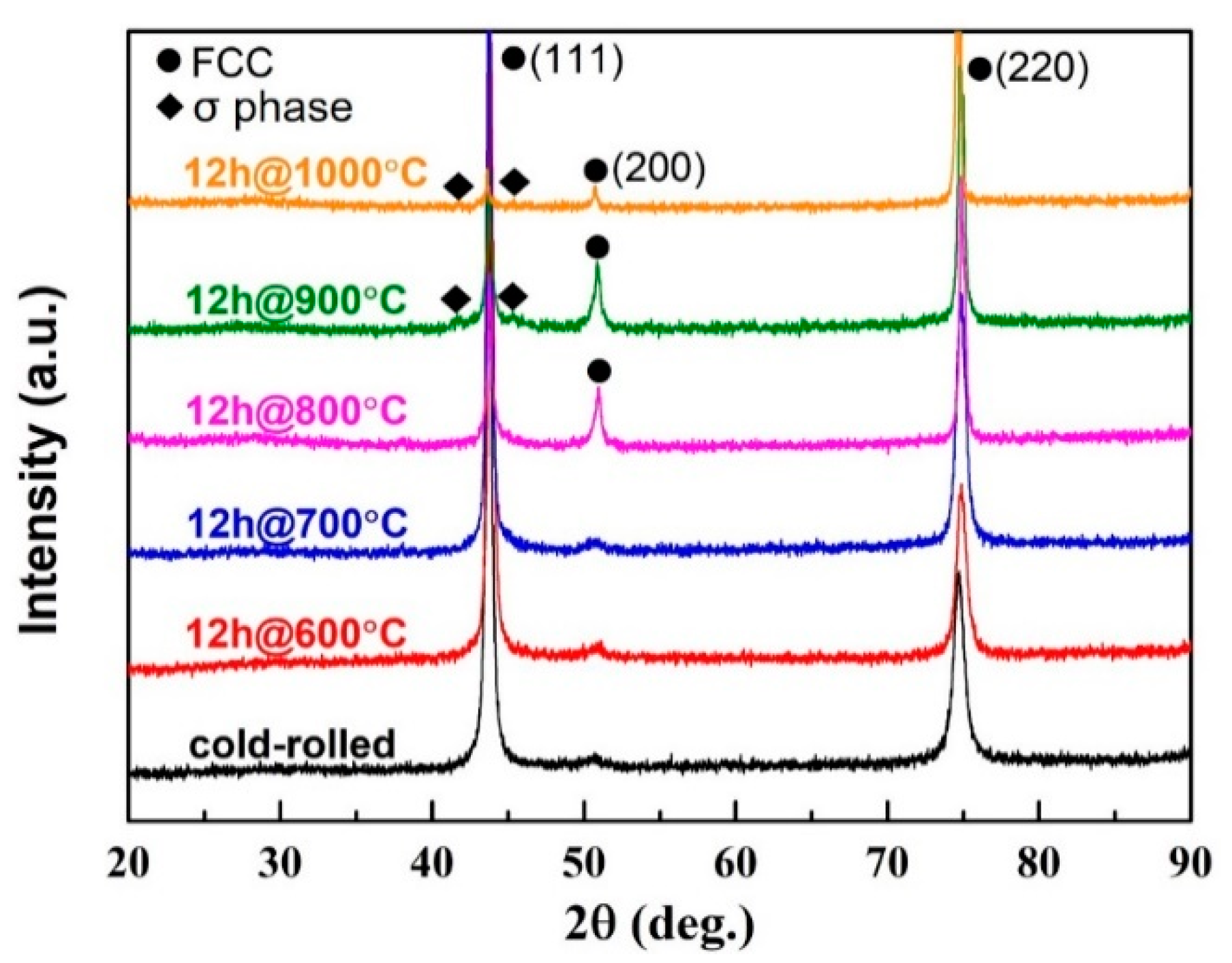
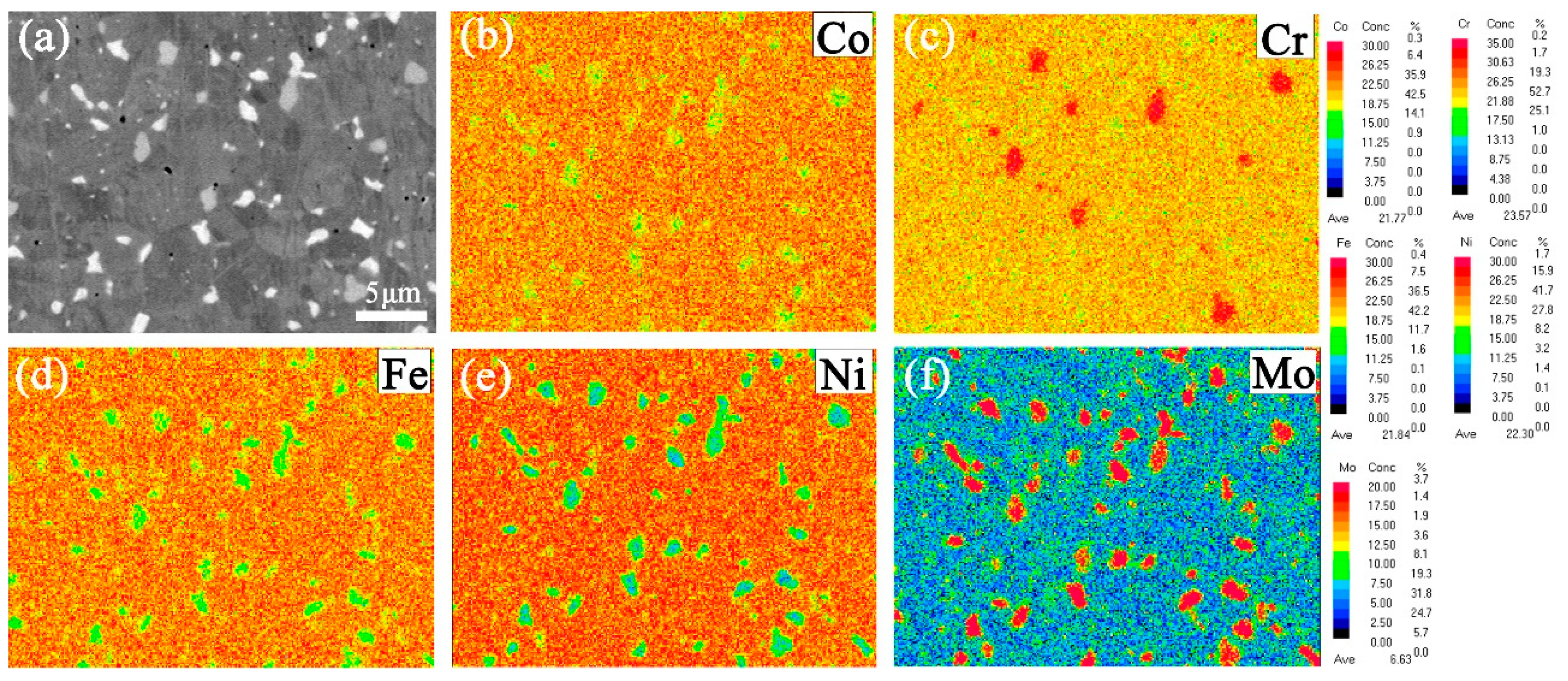
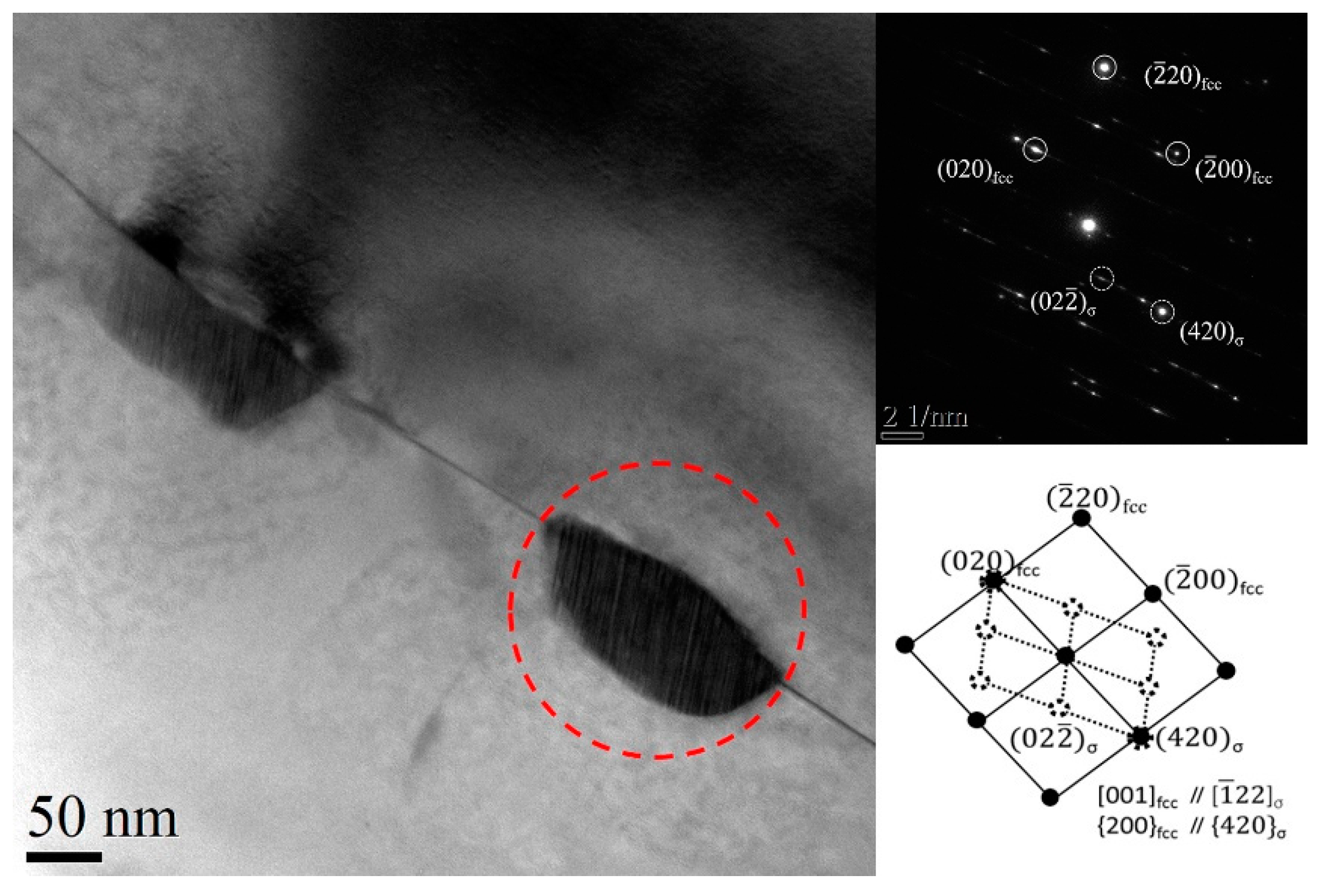


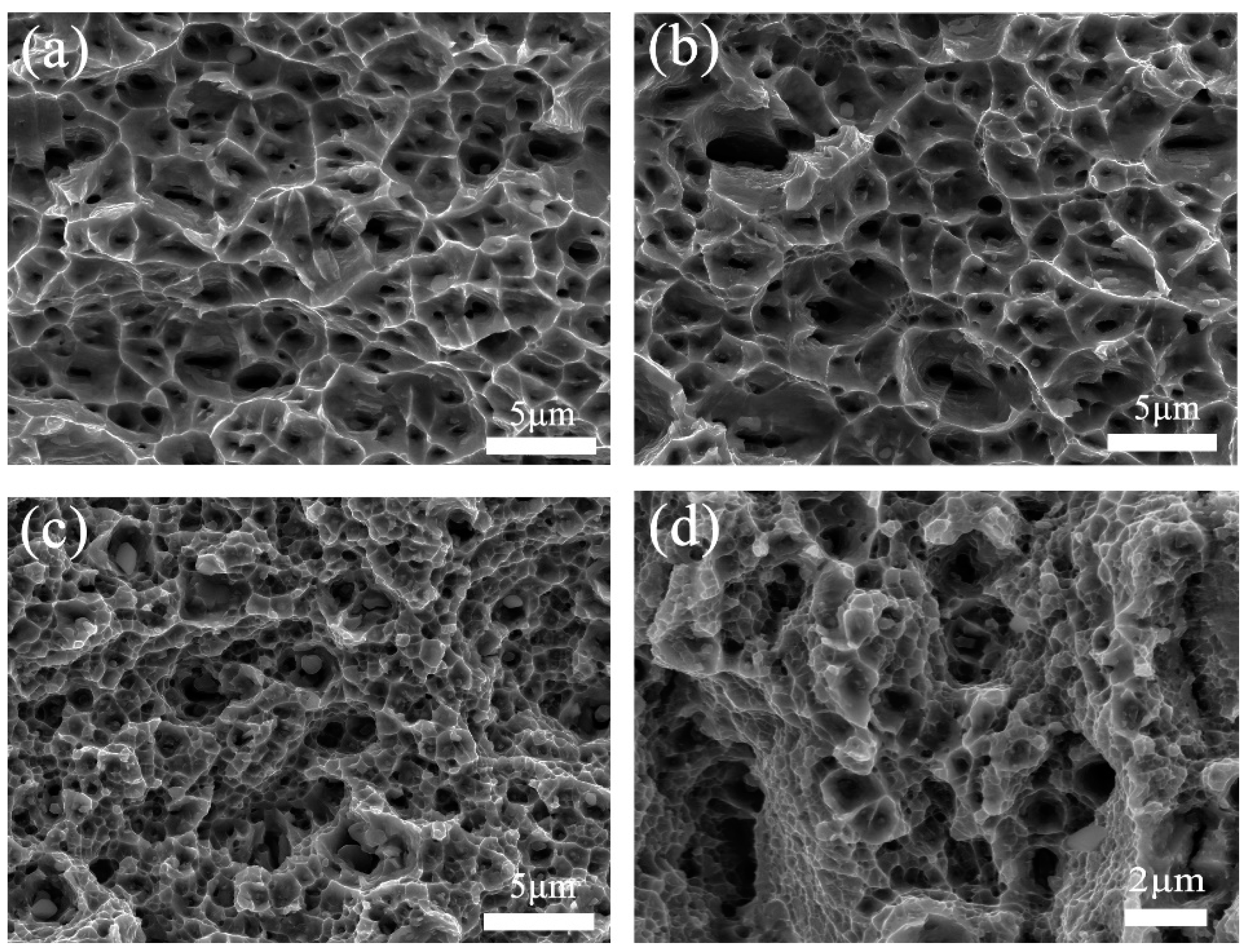
| Element (at.%) | Co | Cr | Fe | Ni | Mo |
|---|---|---|---|---|---|
| Powders | 22.33 | 23.96 | 25.05 | 23.12 | 5.54 |
| Phase | Co | Cr | Fe | Ni | Mo |
|---|---|---|---|---|---|
| FCC (matrix) | 23.71 | 23.98 | 23.51 | 24.44 | 4.36 |
| White precipitate | 21.08 | 25.73 | 17.61 | 11.38 | 24.20 |
| Gray precipitate | 19.55 | 35.78 | 17.51 | 11.44 | 15.72 |
| Samples | YS (MPa) | UTS (MPa) | EL (%) |
|---|---|---|---|
| Cold-rolled | 1392 ± 20 | 1589 ± 9 | 13.5 ± 1.5 |
| 600 °C (12 h) | 1624 ± 10 | 1779 ± 5 | 9.5 ± 0.5 |
| 600 °C (48 h) | 1631 ± 10 | 1869 ± 8 | 8 ± 1 |
| 700 °C (12 h) | 1448 ± 12 | 1645 ± 11 | 10 ± 0.8 |
| 800 °C (12 h) | 834 ± 10 | 1208 ± 25 | 31 ± 1.6 |
| 900 °C (12 h) | 622 ± 8 | 1039 ± 3 | 46 ± 1.5 |
| HEAs | Post-Treatment | UTS (MPa) | EL (%) |
|---|---|---|---|
| CoCrFeMnNi [3] | Cold-rolled and recrystallized | 600 | 60 |
| CoCrFeNiNb0.4 [6] | No treatment | 1004 | 1.3 |
| (FeCoNiCr)94Ti2Al4 [20] | Cold-rolled (30%) and annealed (800 °C/18 h) | 1098 | 39 |
| CoCrFeNiMo0.3 [21] | Cold-rolled (60%) and annealed (850 °C/1 h) | 1187 | 18.9 |
| CoCrFeNiMo0.15 [33] | Torsional-treated 360° | 1000 | 10 |
| Current work | Cold-rolled (80%) and annealed (800 °C/12 h) | 1208 | 31 |
© 2019 by the authors. Licensee MDPI, Basel, Switzerland. This article is an open access article distributed under the terms and conditions of the Creative Commons Attribution (CC BY) license (http://creativecommons.org/licenses/by/4.0/).
Share and Cite
Li, L.; Qiu, J.; Guo, W.; Liu, B.; Zhou, R.; Li, Z.; Liu, Y. Microstructure and Mechanical Property Evolution during Annealing of a Cold-Rolled Metastable Powder Metallurgy High Entropy Alloy. Entropy 2019, 21, 833. https://doi.org/10.3390/e21090833
Li L, Qiu J, Guo W, Liu B, Zhou R, Li Z, Liu Y. Microstructure and Mechanical Property Evolution during Annealing of a Cold-Rolled Metastable Powder Metallurgy High Entropy Alloy. Entropy. 2019; 21(9):833. https://doi.org/10.3390/e21090833
Chicago/Turabian StyleLi, Liangsheng, Jingwen Qiu, Wenmin Guo, Bin Liu, Rui Zhou, Zheng Li, and Yong Liu. 2019. "Microstructure and Mechanical Property Evolution during Annealing of a Cold-Rolled Metastable Powder Metallurgy High Entropy Alloy" Entropy 21, no. 9: 833. https://doi.org/10.3390/e21090833




